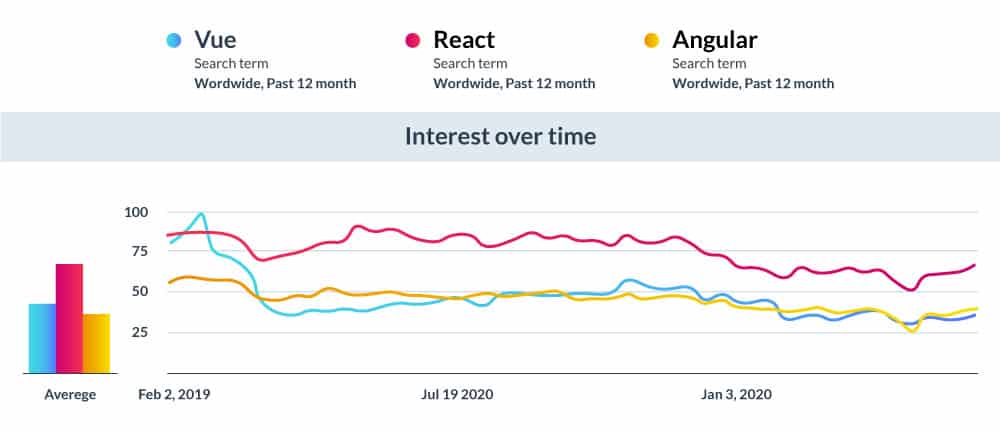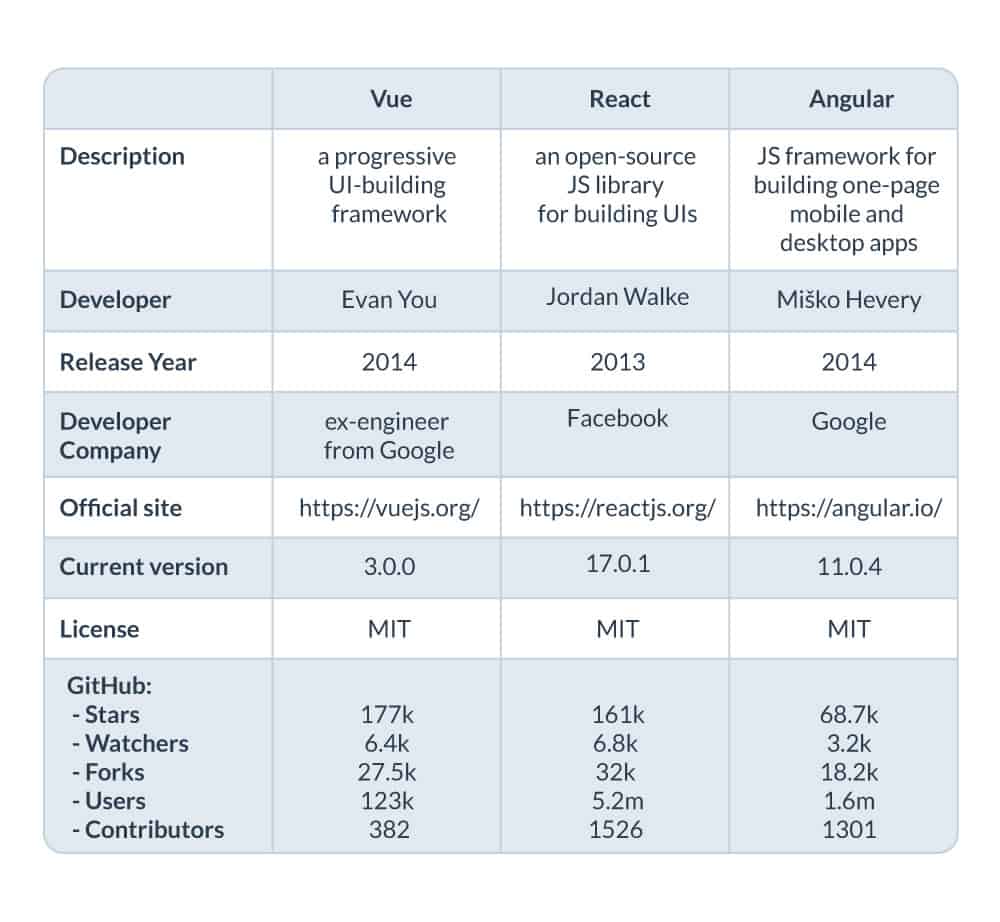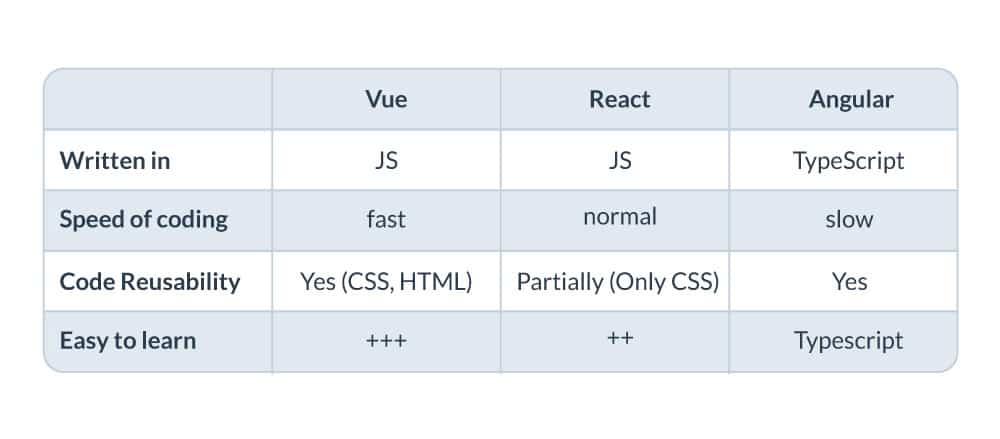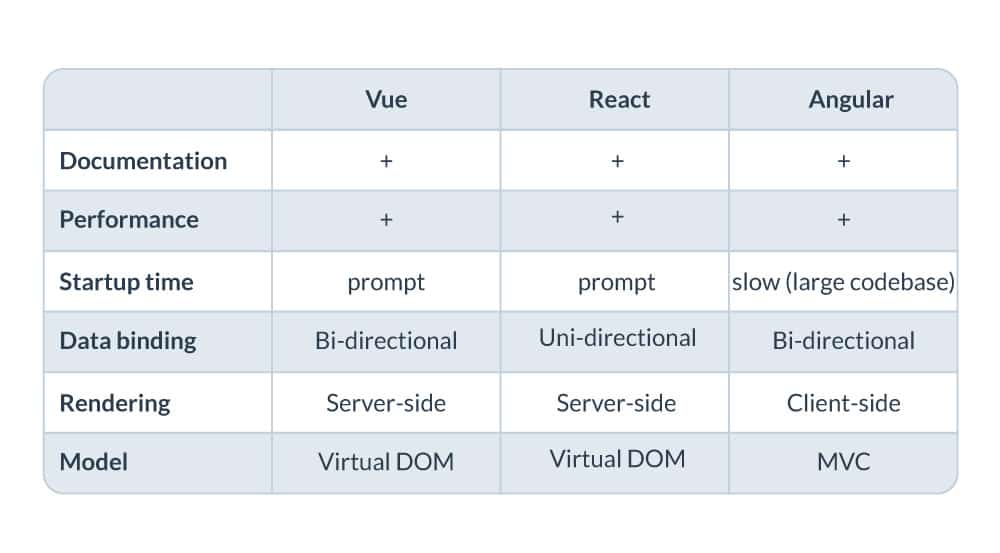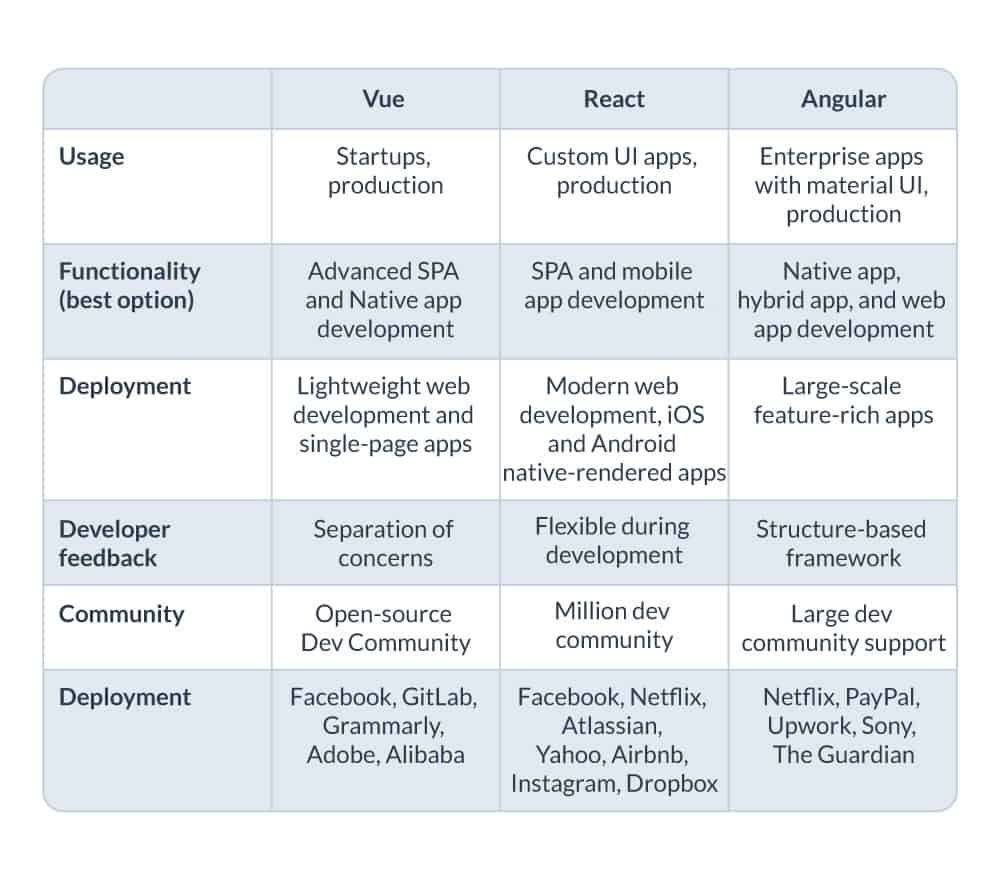Vue vs React vs Angular are among the most popular JavaScript frameworks and libraries today. But which one can be applied to your needs and expectations depends on your goal. While you’re still figuring out a specific aim, we are going to compare Vue vs React vs Angular to make your choice easier.
“You don’t have to be a genius or a visionary or even a college graduate to be successful. You just need a framework and a dream.” – Michael Dell
Vue vs React vs Angular
Vue.js
Vue.js is one of the JavaScript frameworks that has been introduced in 2014 by Evan You (Google’s former employee). It is a progressive UI-building framework that originates from Angular and repeats its inventor’s name. Vue.js is among the most popular frameworks due to being:
- approachable – consists of HTML, CSS, and JS features
- versatile – has the gradually adoptable ecosystem
- performant – works fast on Virtual DOM and has minimum optimization efforts
It is used in web (single-page and multiple-page apps), mobile, and desktop application development. The latter also uses Vue CLI Plugin Electron Builder. Some of the well-known Vue.js users are Xiaomi, Behance, Adobe, Gitlab, Grammarly, and others.
React
React is a JavaScript library released in 2013 by Jordan Walke (Facebook’s employee). It is an open-source library for building interactive UIs. React’s popularity puts it on top of the most loved and used JS libraries due to being
- declarative – painless UI creation, simple view design for each app state, updates and rendering of specific components in data changes
- component-based – single component building to later compose them in complex UIs
- easily learned and applicable everywhere – existing code shouldn’t be rewritten to create new React features
React is mostly used to develop web interactive apps and advance them. There are apps built with React you’ve probably heard about or even used yourself, i.e. Instagram, Facebook, and Netflix.
Need a React js single page application?
Angular
Angular also belongs to the top JavaScript frameworks and is a platform for building single-page apps on HTML and TypeScript. The latter is the code-base of Angular. It was created by a Google team and Miško Hevery in 2014 and rewritten from AngularJS.
Angular is one of the most popular frameworks due to being:
- cross-platform – progressive web applications, native and desktop apps can be built with the Angular reusable code
- speedy and performant – maximum speed possibilities per today and scalability
- variety of tools – declarative simple templates to build features and tool feedback, which allows to shift focus on app amazingness rather than the code itself
Angular is used to build web, mobile, and desktop apps. Such giants as Microsoft, Google’s Gmail, Upwork, Forbes, PayPal, and Samsung accomplish user demand with the help of Angular.
Trends
According to Google Trends on December 8, 2020, React gains the biggest worldwide developer interest of 64%. Then comes Angular with 39% and Vue.js with 37%, respectively.
Source: Google Trends 2020
StackOverflow 2019 Survey shows that both Angular 32.4% and React 32.3% are enlisted in the top 3 leading frameworks/libraries, taking the 2d and the 3d places.
Source: StackOverflow 2019 Survey
On the contrary, NPM Statistics from January-December 2020, puts React forward again with 387,377,909 annual downloads. The second is Vue.js receiving 82,528,227 yearly downloads, and Angular is the third on this list receiving 25,306,935 downloads per year.

The job market popularity also puts React on top. Interest towards React on the market was equal to 39%, while Angular took second place and obtained 20%. Vue.js wasn’t that lucky and received 0% interest worldwide as of December 2020.
Source: Google Trends, December 2020
To sum up, the three sources show that React is the top library used by developers and other tech-savvy people in the world as of 2020. To add, it is also among the top job interests. Afterwards goes Angular and, then, Vue.js. However, it would not be wise to talk about the choice of technology only in light of being trendy and popular in the job market. Your choice should be based on tech factors and framework/library key features.
Key-Feature Comparison
Background
The background of Angular, React and Vue shows data according to technology description, its creator, release year, the developer company, official site, current version, license, and GitHub repository. Here, you can view what stands behind each framework and library as well as visit Vue vs React vs Angular websites.
Therefore, being released with little time difference, React is at the front, followed by Angular and Vue JavaScript frameworks.
Syntax & reusability
Information about syntax and reusability is provided to make code understandable. For example, Vue and React are written in JavaScript, while Angular’s code belongs to TypeScript. The speed of coding of Vue is quite fast as it was designed to fulfill this mission.
React, in its turn, has a normal coding speed that cannot be complained much about, and Angular is relatively slow in coding. Why? It depends on app complexity. It takes a long time to compile an app in Angular and it will also run slower due to a large codebase. If you are likely to pick Angular for your app deployment, learn how to boost Angular-based development first.
What concerns code reusability, Vue allows the use of its CSS and HTML code components, while React shares only its CSS code. Angular’s code is completely reusable. To add, Vue and React have an easy learning curve. To learn Angular, you will have to deal with TypeScript.
Core features
Core features of the two JavaScript frameworks and one JavaScript library point out the way your app will function based on the technology you’ll choose. The biggest asset of Vue and React is that these technologies are powered by Virtual DOM – it is the place where changes are being made to the components of a dynamic website without altering the website’s performance and making responses too long. I.e. page refreshments and the user clicks. Here, Angular is different and its model of work is the MVC.
Model-View-Controller or MVC is a software design pattern used in web app development. MVC works by isolating app logic from the UI layer and maintains separation of concerns. Requests of an app received by the Controller and works with the Model leaving the View time to get prepared. Afterward, the View uses controller data to generate the response. Sounds pretty simple, but you can also have a look at the visual support of the MVC functionality below.
To proceed, Vue and React are both rendered on the server-side, while Angular is rendered on the client-side. Data binding, which is an app UI and data displayed connection, is bi-directional (having two-way data-sharing ability by the app components) in Vue and Angular. React has unidirectional data sharing (one-way data binding, respectively). The startup time of Vue and React is quite fast, while Angular starts slow. Both of the frameworks and library have documentation and performance explained.
Usage
Usage demonstrates the most important information you need to choose from a JS framework/library. Here, Vue.js is used in production, mostly by Startups to develop advanced SPA (single-page applications) and native apps. Vue.js popularity lies in its lightweight and single-page web development. Developers find Vue easy to learn and code with due to separation of concerns – each section has its functionality and set of issues. Besides, Vue has an open-source developer community and support, which makes it easier for newcomers to get along.
React, in its turn, is a library used in production and to develop custom UI applications. It is applied when there is a need in SPA and mobile app development. React is best suitable for modern web development, and Android or iOS native rendered applications. It is quite flexible due to partial code reusability, especially of its CSS code. React also has a million developers community that provides support to the younger generations of developers.
Angular is also used in production, however, it is best to use it in enterprise app deployment, especially the ones with material UI. It applies to Native, hybrid, and web app development. Angular helps produce feature-rich and large-scale apps because it’s a structure-based framework. Like Vue vs React, Angular has a large community of developers that support the Angular.js learning curve.
Bonus link: Python vs .Net core: key differences
Wrapping Up
To conclude, Angular, React, and Vue are the three most-used technologies in the world. React’s popularity is obvious based on the leading positions on all of the infographic data. What concerns functionality and core features, each framework/library is used for specific web applications. As Angular, React, and Vue have different feedbacks and roles in app building, it is vital to understand when, where, and how they are applicable in every single case.
Remember, Vue is used to build SPAs, web UIs, apps for mobile and desktop: it is fast and startups like it. React also builds SPAs, but more advanced versions, and UIs: it is pretty fast and its code is reusable. Angular has the potential to build enterprise apps, be it web, mobile or desktop ones. However, it is slow and there’s a large codebase to deal with. Angular.js learning curve, e.g. TypeScript isn’t as easy to learn as JS code used by Vue or React.
Hence, hard reasoning should prevail in your choice. Besides, it depends on your needs. Figure out what technology meets those needs in the first place and create a strategy that will lead your choice among Angular vs React popularity or Vue.js popularity.
What about future trends? Angular, React and Vue will be among the top JS frameworks/libraries, where Angular and React are going to be unquestionable leaders. And Vue is going to gain more popularity and enclose the trinity of leaders in the years to come.








